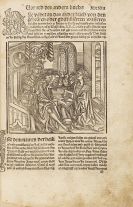
Michelangelo Buonarroti
Caprese
1475 -
Rom
1564
Michelangelo Buonarroti counts among the most renowned artist of Italian Renaissance. In the course of his long life he was not only celebrated for his achievements in painting and sculpting, but also for his talents as an architect, additionally, numerous poems by his hand have been passed down.
Michelangelo Buonarroti was born in the small village of Caprese in 1475. The little boy's enormous talents showed from an early point on, so that his father Lodovico agreed to send Michelangelo to the renowned Ghirlandaio workshop in Florence. Michelangelo Buonarroti was accepted into the garden of Lorenzo de' Medici presumably in 1490. His first sculptures originate from the time up until 1492, they were executed in this extremely fruitful atmosphere under the aegis of experienced teachers. Important works from this period are "Madonna of the Steps" and "Battle of the Centaurs".
After Michelangelo was celebrated in the following years for works such as "Bacchus" or the "Roman Pietà", he was commissioned to execute "David" in 1501. "David" (1501-1504) rightfully counts among the artists best known works, as Michelangelo made his masterpiece from just one block that two artists had already worked on before him. Shortly after he had completed David, Michelangelo Buonarroti traveled to Rome, in order to begin working on what was by then his career's greatest commission, the tomb of Pope Julius II. Due to numerous new contract conclusions with the pope's progeny, the project lasted up into the 1540s. As early as in 1508 pope Julius II was once more client of Michelangelo when he ordered him to execute the ceiling of the Sistine Chapel. By means of an enormous physical effort and in an so far unknown manner - the artist painted overhead - Michelangelo Buonarroti created a striking world of images from the genesis, among others, Adam's enlivenment, and adds fascinating figures such as the Sibyls, the prophets or the famous "Ignudi". Over the following years he made the tombs of the Dukes of Medici, Giuliano and Lorenzo, in the Florentine church San Lorenzo or the drawings for the young Roman Tommaso de' Cavalieri, which can also be counted among the highlights of his oeuvre.
Between 1536 and 1541 Michelangelo Buonarroti completed the painting in the Sistine Chapel on the altar wall with the magnificent "Last Judgement", which follows a fascinating image concept, then he did the frescoes "The Conversion of Saul of Tarsus" and "The Crucifixion of Saint Peter" in the Cappella Paolina, which completed his life's work at an old age. The most important architectural task of Michelangelo also took place in the 1540s, when he was leading the construction of St. Peter's Basilica.
The "Florentine Pietà", which Michelangelo began around 1550, and which was modeled to adorn his own tomb, can be regarded the highlight of his later sculptures. Michelangelo died in 1564.
Today we do not only encounter life and work of Michelangelo Buonarroti in form of his works. Additionally, it is the descriptions of his life by the biographers Giorgio Vasari and Ascanio Condivi, as well as his countless letters which have greatly contributed to our concept of Michelangelo Buonarroti as man and artist.
Would you like to sell a work by Michelangelo Buonarroti?
Infos for seller






